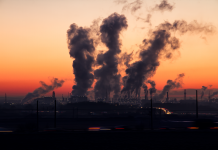This article is written by Abhinav Rana, from University School of Law and Legal Studies, GGSIPU Dwarka. This article deals with the Indirect Impact of COVID-19 on the environment.
The outbreak of the pandemic COVID-19 has brought a drastic decrease in industrial activities, tourism, and various other outdoor activities. The year 2020 was expected to be ‘Super year for nature’ as a large number of meetings were scheduled for discussion and negotiation about the ‘Post-2020 Biodiversity Framework’. The reports from all over the world show that the environmental conditions including air, water, and river quality are improving. The least human interaction with nature has proved to be a blessing to the environment. The major sectors which result in air pollution such as power plants, industries, biomass burning, road dust resuspension, construction activities, and landfill fires etc. were suspended due to the national lockdown and as a result improvement in air quality can be noted in many areas. Due to less use of industries, the demand for fossil fuels was less and thus, the ecosystem is being recovered.
This paper provides for insight into the improvement of air, water quality and the effect of the national lockdown on the environment. The research further includes the case study on air quality of Ghaziabad (Uttar Pradesh) which is one of the world’s most polluted cities (IQAir 2019).
Introduction
Worldwide spread of the virus COVID-19 in such a short span of time has led to a conspicuous decrease in traffic, tourism, and manufacturing activities. It is the 3rd time we can trace the spread of novel virus since the last two decades, in 2003, Severe Acute Respiratory Syndrome (SARS) and in 2012, Middle East Respiratory Syndrome coronavirus (MERSCoV).
India has likewise seen a fast expansion in assembling and modern development which prompted increment in the way of life of the destitute individuals. But we had to pay a really huge cost for this development. It tends to be followed from the public statement of WHO, 2018 that around 7 million individuals die each year because of contaminated air. Further, the State of India’s Environment, 2019 has additionally announced that 12.5% of deaths in India were because of Air Pollution. The climate in India was amazingly debased and all poison levels and the air quality list left the cutoff points a long way behind. Despite the fact that the pandemic circumstance is wild for people, its positive side has made us rethink our lives and revamp them in manners that have less effect on our planet. Metropolitan air quality administration procedures were arranged and centered around control systems, and public cooperation. Migrant workers from India’s different urban areas and towns were additionally vigorously influenced because of the lockdown. With production lines and work environments shut down, they were left with no job. The agriculture sector area has also been influenced because of COVID‐19.
There has been an escalation of wheat, vegetables, and different yields during the pandemic. This transient change in human practices raises the interest in lessening the utilization of common assets. This features how the earth can reestablish its wellness without individual’s aggravation. Along these lines, ecological guidelines should be executed after COVID-19 to cultivate the earth’s recovery. Notwithstanding, the agricultural outputs are unable to reach the consumers due to supply chain issues. In the initial not many days of the lockdown, television screens captured long processions of migrant workers walking miles to go back to their native villages, frequently with families and little youngsters on their shoulders. With no work, no compensation, and incapable to arrive at their towns attributable to the restrictions, the life of the traveler’s laborer has become miserable. However, on the opposite side, the pandemic has brought about an expansion in the measures of bio‐medical and unsafe waste. Besides, the use of plastics has expanded and reusing of wastes has decreased which can be a worry later on.
COVID-19 and its effect on environment
The COVID-19 pandemic has affected human life and the global economy in all respects. The number of new cases and deaths is growing at an alarming rate with no signs of control yet, making predictions of its economic and other effects uncertain. Depending on the level of impact of COVID-19 in each country, as well as the specific circumstances and capacity of each country, governments around the world are adopting different levels of interventions, including travel restrictions and blocking, to prevent the spread. highly contagious virus.
The economic recession caused by the Covid-19 pandemic had two enormous effects on our environment. It has significantly improved the quality of our air and water and significantly reduced our material consumption, water use and waste generation. Due to the unusual COVID-19 outbreak, almost each and every large and small cities and villages in affected countries such as China, Italy, United States, France, Iran, Germany, South Korea, United Kingdom, India, Australia and others were in partial/total lockdown for a long period ranging from weeks to months. The main sources contributing to air pollution are transportation, industries, power plants, construction activities, and biomass combustion etc. As part of the national lockdown, all transport services – road, air and rail were suspended except for essential services. As a result, an improvement in air quality was noted in many cities around the world.
Due to the non-functioning of industries, industrial waste emissions have decreased to a huge extent. Vehicles and public transport were barely found on the roads, resulting in almost zero emission of greenhouse gases and other particles suspended in the environment. Due to less demand for electricity in industries, the use of fossil fuels and other sources have been greatly reduced. In many large cities, people experienced clear skies for the first time in their lives. The level of pollution in tourist sites such as forests, beaches, hills, etc. also decreases considerably. The ozone layer has recovered to some extent. The pandemic has shown its contrasting consequences on human civilization, in that, on the one hand, it caused a situation of global panic, but created a very positive impact on the global environment on the other.
Due to the coronavirus outbreak, some developed countries have abundant environmental sustainability programs like the United States, some cities and small municipalities have suspended waste recycling facilities due to concerns from authorities spreading the virus in recycling centers. Similarly, Italy asked its infected citizens to stop sorting and sorting waste in their homes and offices. On the other hand, many other European nation states, especially those hardest hits by the pandemic, have restricted the sustainable waste management system. In addition, many companies, institutions and restaurants have reinitiated the trend of using disposable plastic instead of reusable bags and containers. The inorganic waste and organic waste drive are unevenly complemented by various environmental problems and issues such as water pollution, soil erosion, air and deforestation. Policies adopted by different governments, such as lockdown and quarantine in many countries during the coronavirus epidemic, have created a new demand in the market for online shopping and home delivery systems. Therefore, organic waste generated has become very high in households. On the other hand, sending foods placed on the internet in single use, plastic bags and containers caused an increase in inorganic waste.
This article shows that the pandemic situation generally improves air quality in cities around the world, reduces GHG emissions, water and noise pollution, and also the pressure on tourist destinations, which can help restore ecological systems. Further, COVID-19 also has negative impacts, such as an increase in medical waste, the random use and disposal of disinfectants, masks and gloves; and untreated waste loads that continually endanger the environment. Data from the Central Pollution Control Board and Uttar Pradesh Pollution Control Board show that the water from the Ganges carries more dissolved oxygen and less nitrate through its most polluted area in Uttar Pradesh. These conditions help aquatic life survive. Biochemical oxygen demand (BOD) decreased accordingly with the total coliform concentration, which is evidence of an improvement in water quality.
Similar positive developments have been reported for Yamuna. Not only the Ganga river, but even the Yamuna waterway has also seen a critical improvement in water quality and amount. Besides, as a result of the contemporary rainfall, the water levels have likewise improved. Since there are less vehicles out and about, contamination and air quality list have improved radically. As of late, some migratory birds were likewise observed returning and also the marine life. More importantly, the national closure has significantly reduced the generation of urban solid waste (MSW). Pune’s daily MSW tonnage fell 29%, while Chennai and Nagpur fell 28% and 25% respectively. Even in cities like Delhi and Mumbai, a similar decline can be expected due to shifts in consumer demand and behavioral shifts towards sustainable consumption.
All waste created by biomedical examination foundations, health facilities, clinical research centers, and waste produced from dissipated or minor sources is medical care squander. While medical clinics create an enormous volume of health waste, still, they produce a little extent of waste among the absolute number of sources. The COVID-19 emergency has an expanding ecological effect connected to higher plastic utilization and further removal, yet the expanding basic medical issues have significantly amplified the current danger.
All waste created by biomedical examination foundations, health facilities, clinical research centers, and waste produced from dissipated or minor sources are medical care squander. While medical clinics create an enormous volume of health waste, still, they produce a little extent of waste among the absolute number of sources. The COVID-19 emergency has an expanding ecological effect connected to higher plastic utilization and further removal, yet the expanding basic medical issues have significantly amplified the current danger.
Impact on Air Quality
Ghaziabad is the largest city in Uttar Pradesh (West and is also the part of the National Capital Region (NCR). It has more or less the same environmental conditions as that of Delhi. The city has unfavorable pollution problems mainly due to traffic congestion and dust. In a recently released IQ Air 2019 Global Air Quality Report, it is found that out of 20 most polluted cities in the world, 14 are from India and Ghaziabad is in first place with PM2 pollution level. This indicates a huge degree of air pollution that could not be controlled by the state or central government even after several efforts.
Impact of Lockdown on Ghaziabad District
In order to study the environmental impact of the containment on the air quality of Ghaziabad district, the 24-hour average concentrations of four main pollutants on specific dates were compared with the concentration data from the previous year respectively. The initial three dates (January 10, January 30 and February 19) reveals to us the condition “before lockdown” was forced and the fourth date (March 10) speaks to the dates when social removing was somewhat followed and the other two dates (March 30 and April 19) speak to an exacting lockdown condition during the year 2020.
The convergence of these four contaminations on April 14, 2020 (a day ago of the first lockdown) was likewise contrasted with the fixations on January 14, 2020 (air quality, 3 months back) and April 14, 2019, to evaluate the rate decrease. of the toxin focus and the outcomes are very good. The decrease in the convergence of four principle toxins because of the lockdown, in a roundabout way because of COVID-19, demonstrates that a decrease of up to 85% in the grouping of PM2.5 has been seen in one of the most polluted cities in India.
Impact on River Quality
Articles and reports in daily newspapers and other electronic media uncover the improvement in the nature of a considerable lot of India’s streams, including the Ganga and Yamuna, and so on. The main cause is the lack of industrial effluents entering the rivers due to the lockdown situation in this pandemic situation. Components have additionally added to improving the nature of streams, for example, weighty snowfall presently softening with summer, diminished interest for water system water, better than expected precipitation and furthermore human elements, specifically the decrease of strict and social exercises, for example, puja, swimming, incinerations on the banks of waterways.
Continuous water observing information given by the CPCB demonstrates that 27 of the 36 checking units were put at various areas where the Ganga stream streams were considered appropriate for the proliferation of natural life, fishing and swimming (The Tribune, 2020).
The natural burden can be weakened in the waterway, yet mechanical contamination obliterates oneself cleaning property of the water. Analysts accept that oneself cleaning property of the Ganga River has improved, which improved water quality by 40-half during this lockdown. Researchers have asserted that water quality has improved amazingly in Haridwar Ghats, which is in accordance with utilization norms. The Ghats are likewise shut for individuals washing up in the water or emptying blossoms and other waste into it. This caused the water to show up noticeably cleaner with the amphibian life moving.
Other Indirect effects on the Environment
Some countries, such as China, have asked their authorities and local government bodies to strengthen their disinfection routines, mainly to increase the chlorine dose in sewage treatment plants to stop the spread of the virus, but on the other hand, there is solid evidence that the Coronavirus survives in wastewater and drinking water (WHO, 2020). Excess chlorine in the water can cause harmful problems and health problems for people such as bladder cancer, as well as damage cells.
COVID-19 is a reminder that human health is linked to the health of the planet. Coronaviruses are zoonotic, meaning they are transmitted between animals and humans. They represent seventy-five percent of all infectious diseases that occur. As the coronavirus is spreading rapidly around the world, the top priority for governments and institutions is to control the spread of the virus, but soon we must shift the focus to managing and treating waste (especially waste clinicians and doctors) that have been produced worldwide. Likewise, at the same time, we as individuals must take steps and follow the necessary guidelines to dispose of waste and medical equipment.
However, these actions can reverse the beneficial environmental impacts from the pandemic response. A similar situation can be seen in the 2008 financial crisis: despite a temporary reduction in emissions of 1.3%, while the economy recovered in 2010, emissions reached an all-time high. After all, we can only see that the world has emerged stronger from this global pandemic through mutual empathy and goodwill. To prevent future epidemics, we must address threats to ecosystems and wildlife, including habitat loss, illegal trade, pollution, and climate change.
The way forward
The benefits arising to the environment out of the national lockdown due to the COVID-19, can be found heartening, cleaner air, no traffic, less noise pollution and much more. However, on the other hand some of the experts fear that it provides a huge amount of risk to the future with more traffic, more pollution, and climate change. According to Professor Corinne Le Quere, University of East Anglia, “We still have the same cars, industries, houses and other things, as soon as the restrictions will come to end, we will go right back to the place we were ”. Since the COVID-19 pandemic, the production of medical waste has increased worldwide, posing a major threat to public health and the environment. For the collection of samples from patients suspected of COVID-19, diagnosis, treatment of large numbers of patients and disinfection, a lot of infectious and biomedical waste is generated by hospitals.
A pandemic of such magnitude naturally has destructive effects on the environment. One of these concerns medical waste resulting from increased medical activity. It was said that during the period when the pandemic peaked in Wuhan, an average of 240 tons of medical waste was produced per day in hospitals and this value was 6 times higher than the normal value. Increased production of municipal waste (organic and inorganic) has a direct and indirect impact on the environment such as air, water and soil pollution. Because of the pandemic, quarantine policies imposed in many countries have led to an increase in demand for online shopping for door-to-door shipments, which in turn increases the amount of household waste from packaging sent. Because of the pandemic, numerous nations have delayed waste reusing exercises to lessen the transmission of viral diseases. For instance, the United States has restricted reusing programs in numerous urban communities (almost 46%), in light of the fact that the public authority is worried about the danger of spreading COVID-19 in reusing offices. As of late, a lot of disinfectants have been applied to streets, business and local locations to battle the COVID. Substantial utilization of disinfectants can murder non-target valuable species, which can make natural irregular characteristics.
Conclusion
COVID-19 and lockdown provided us with a unique opportunity to improve the impact on the environment. We can see clean air, water, and livable cities that we have been asking for so long because of the national lockdown imposed. So, before returning to life as usual, we must commit ourselves to instilling the principles of sustainable development in our social behavior, our lifestyle and the development of public policies to make our environment clean and sustainable.
The Air Quality Index (AQI) in all states in India is currently in twofold digits (showing modestly great air quality) after this lockdown. The air, however, the waterways of India like Ganga, Yamuna and Kaveri and so on have gotten spotless and clear and marine life is noticeable. In the wake of inspecting different reports referred to above, it tends to be summed up that COVID-19 has without a doubt welcomed a horrible and pulverizing plague on people, however, it has arisen as a gift for the regular habitat by offering it an “opportunity to unwind.” recuperation”. We have additionally discovered that human-caused natural debasement isn’t totally irreversible. In the space of only 1 to 2 months, everybody is seeing the “rebuilding of nature”. It is a sign for us to comprehend and respond. Government and strategy creators should find a way to guarantee that this mending cycle doesn’t get transitory. Research is focusing on changes in air quality during the lockdown period.
Along these lines, we can say that straightforwardly / by implication, the pandemic has influenced human existence and the worldwide economy, which eventually influences the climate and atmosphere. In spite of the fact that the effects of COVID-19 on the climate are not that long haul, time proficient and joined strategies can help in improving the ecological supportability from the impacts of worldwide environmental change.
LawSikho has created a telegram group for exchanging legal knowledge, referrals and various opportunities. You can click on this link and join:












